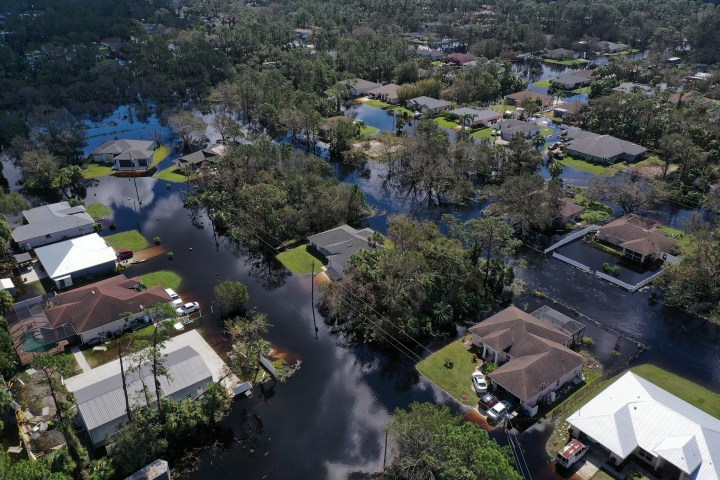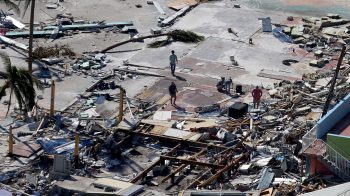
“Our whole life is in this house”: Florida residents begin recovery after Hurricane Ian
“Our whole life is in this house”: Florida residents begin recovery after Hurricane Ian

Season 2 of “How We Survive“ launches next week and focuses on housing and climate change in South Florida. You can listen to the trailer for Season 2 now.
It’s been two weeks since Hurricane Ian slammed into Southwest Florida in late September. Across the state, more than 120 people died in the storm and its aftermath. The economic damage could exceed $100 billion, according to catastrophe modeling firm Karen Clark & Company. An estimated $63 billion of that is insured.
I’ve spent the last six months reporting on housing and climate change in South Florida for the latest season of “How We Survive.” Last week, I traveled down to the Fort Myers area to talk to survivors left picking up the pieces.
Thomas Eaton rode out the storm at his home in North Port, a small city on the Myakka River. “It was scary. I was watching the waves hit my bedroom window,” he said.
Eaton’s neighborhood is miles from the coast and was not under an evacuation order. But when Ian came, it sat over North Port, dumping more than 20 inches of rain over three days.
Floodwaters rose to about four and a half feet inside his house, Eaton said.
“The water was coming through the walls,” he said. “I thought I was going to see Jesus. I just laid on my bed and watched out the window and just watched it all.”
I met Eaton at a temporary shelter up the road from North Port at Venice High School.
Inside the gym, about a hundred air mattresses were spread out across the floor. An elderly man in American flag shorts rested on one of them as a woman gently washed his feet.

The shelter was being operated by the county school district. Jody Smith is a social worker with the district. Instead of counseling students — on that day — she was helping storm victims.
“Right now we’re just focusing on keeping families safe and fed,” Smith said. “If they need a shoulder, we’re a shoulder. If they need a blanket, we get them a blanket.”
When Ian hit, Passion Pressley and her daughter Ronesha Taylor spent a terrifying night at home as the winds of more than 100 miles per hour pounded their windows.
“Oh, we were praying,” Taylor said. “I felt like Dorothy on ‘The Wizard of Oz,'” said Pressley.
The adults took turns bracing the doors with their bodies while the kids sheltered in a closet. “They were scared. They were scared,” Pressley said.
The family of seven made it through the night, but then couldn’t escape the floodwaters. For almost a week, they were stuck in their house without power or internet access, until a pair of airboats finally came to rescue them.

“It looked like a swamp, with houses on top of the water,” Taylor said. “And then the road is completely closed, and we don’t know when we’ll be able to even check the house to make sure we don’t have any damages inside.”
“And they’re still recovering bodies,” Pressley added.
So, they were left to wait. T-Mobile donated some phones, Pressley said, so people could call family members and insurance companies.
I met 72-year-old Nina Migliaccio as she stood outside the gym, holding a little black and white dog with a pink leash.
“This is Candy,” she said. “Six years old. Chihuahua.”
Migliaccio and her husband Carl had been in the shelter for almost a week. The Red Cross had finally arrived that day and Migliaccio was eager to get medical help. She was almost out of her medicine.

“We need doctor attention. My husband [is] disabled and myself, I have leukemia,” she said.
Given all she’d been through, Migliaccio looked remarkably put together, in a clean shirt and cargo pants with silver sandals. Turns out, those were the clothes she had evacuated in. She had been washing them in the shower, then wearing them in the sun to dry out.
She wasn’t sure when they’d be able to return home. Big chunks of the roof were missing, and she wasn’t sure how much their insurance would cover.
“We cannot go back,” Migliaccio said. “You must have a roof.”
Though she’d been able to rescue Candy, they had had to leave behind their African Grey parrot, Rocky. “I worry because over one week he was without water.”
So, the next day, I drove to North Port to see if I could check on Rocky. The water had receded on Miggliacio’s street, but evidence of the damage was everywhere. You could see big pieces of the roof blown off and debris was strewn all through the yard.

I walked around back — past the small swimming pool filled with black water — and took a peek inside, where a large bird cage sat empty.
I gave Nina Migliaccio a call. She said the cage was empty because someone had come by with the police to rescue Rocky.
Migliaccio said she and her fellow evacuees had been told they’d be moving from the high school to a recently closed hospital in Venice. She was looking forward to having a private room there.
When I looked around her neighborhood, it was clear that it was going to be a while before she and Carl could come home. The house was in bad shape. I described the damage to her over the phone.
“There’s still a lot of debris here,” I told her. “Did your neighbor have a carport that blew down?” It might be the remains of a shed, she said.
A few doors down, a family was sifting through the wreckage of a little beige house with teal trim.
“My entire back roof is gone, my lanai is gone, there’s holes in my ceiling, where water came in. My windows in the back are all gone,” said Sasha Greto, who lives in this home with her family and two dogs.

She was hauling waterlogged furniture to the curb. “Every belonging we own is considered a loss.”
Even though it’s 15 miles from the coast, Greto’s neighborhood flooded when a deluge of rain caused the nearby Myakka River to overflow.
One of the area’s many canals runs just behind their house. “We literally were walking in waist-deep water,” Greto said. “Our feet were covered in bruises and cuts, and that’s for everybody here. It was, it was awful.”
Homeowners’ insurance will cover some of the wind damage, she said. But the family doesn’t have flood insurance.
“And a lot of people in this neighborhood do not because this is not considered a flood zone. So these are blue-collar people working paycheck to paycheck,” she said. “We’re going to pay our electric bill, not get flood insurance if it’s not a requirement.”
So Greto was doing the cleanup herself, with help from friends and family. A former neighbor drove down from Michigan to help, bringing a camper for them to sleep in at night.
“I can say this: We’re alive,” Greto said. “All of this can be replaced.”
At another house around the corner, a pile of mattresses, sofas and appliances sat on the driveway. On a giant piece of plywood, someone had scrawled in big black letters: “Do not take anything. Insurance coming.”

“We have lived in North Port for 19 years,” said Pam Brownell, who lives in the house. The Brownells do have flood insurance — by sheer luck.
“A corner of our pool cage is in a required flood zone,” she said. “And because it’s attached to a structure attached to our home, we’re required to have it, and while we complained about it — the extra costs every year — we’re extremely grateful that we had it. And I would never go without it again, required or not.”
Inside their house, there was a layer of stinky black muck on the floor and a water line two feet high on the wall.
Pam, her husband Mike and their teenage daughter rode out the storm in an interior hallway with their chihuahua Finn. It was their daughter’s 16th birthday.
There was one harrowing moment when a bedroom window shattered; Mike struggled to hold the door to the room shut to keep the wind out.

“The door was flexing and it wanted to come open, and then we ran a screw, I don’t know, somewhere in here,” he said, pointing to the door frame. “Had we not done that, we probably would’ve lost the roof of this house. I mean, it was just like a 900-pound man was trying to come through this door. It was just, ‘Boom, boom, boom, boom, boom, boom, boom!'”
They huddled around a radio and tried to get updates on the storm from friends and family.
“They were telling us four more hours,” Mike said, “and we’re like ‘four more hours?'”
“Our daughter started to freak out at one point,” Pam said, “and I said to her, ‘I know this is scary, but I need you to focus and I need you to keep yourself together. There will be plenty of time for tears tomorrow, but today, I need you in your right mind.’ So she pulled herself together, and I’m not sure a lot of other kids could have, but we got through it.”
Now, the family plans to rebuild. “Our whole life is in this house. We can’t necessarily go anywhere else,” Pam said.
Pam knows sea level rise is making coastal living riskier. And if she were closer to the coast, she’d consider moving. But this far inland? “This was, you know, as they call it, ‘the hundred-year storm.’ So historical flooding.”
She just hopes history won’t repeat itself.
Additional reporting by Caitlin Esch.
There’s a lot happening in the world. Through it all, Marketplace is here for you.
You rely on Marketplace to break down the world’s events and tell you how it affects you in a fact-based, approachable way. We rely on your financial support to keep making that possible.
Your donation today powers the independent journalism that you rely on. For just $5/month, you can help sustain Marketplace so we can keep reporting on the things that matter to you.

















